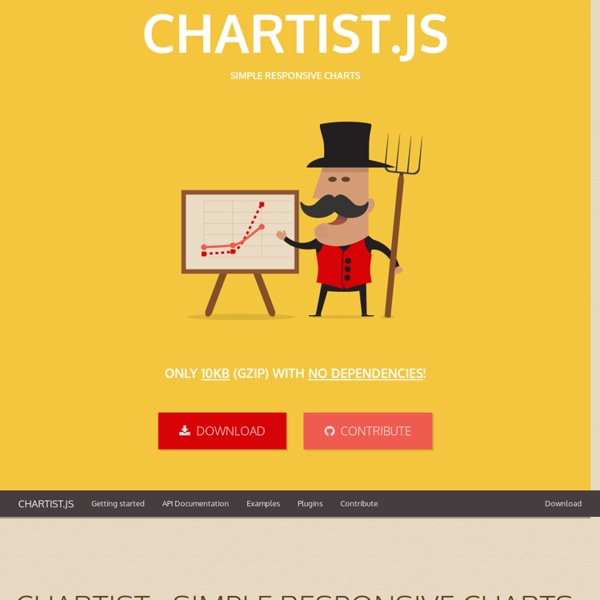Chartist - Simple responsive charts
You may think that this is just yet an other charting library. But Chartist.js is the product of a community that was disappointed about the abilities provided by other charting libraries. Of course there are hundreds of other great charting libraries but after using them there were always tweaks you would have wished for that were not included. Highly customizable responsive charts Facts about Chartist The following facts should give you an overview why to choose Chartists as your front-end chart generator: Simple handling while using convention over configurationGreat flexibility while using clear separation of concerns (Style with CSS & control with JS)Usage of SVG (Yes! These projects and wrapper libraries are known to me right now that either use Chartist.js or wrap them into a library for usage in a framework. Cross-browser support Note that CSS3 animations on SVG CSS attributes are not supported on all browsers and the appearance may vary.
Datavisualization.ch Selected Tools
reveal.js - The HTML Presentation Framework
All posts
Marcin Ignac Data Art with Plask and WebGL @ Resonate My talk at Resonate'13 about Plask and how I use it for making data driven visualizations Fast Dynamic Geometry in WebGL Looking for fast way to update mesh data dynamically. Piddle Urine test strip analysis app Evolving Tools @ FITC My talk at FITC Amsterdam about the process behind some of my data visualization, generative art projects and Plask. Ting Browser Experimental browsing interface for digital library resources Bring Your Own Beamer BYOB is a "series of exhibitions hosting artists and their beamers". Bookmarks as metadata Every time we bookmark a website we not only save it for later but add a piece of information to the page itself. Timeline.js A compact JavaScript animation library with a GUI timeline for fast editing. SimpleGUI SimpleGUI is a new code block developed by me for Cinder library. Cindermedusae - making generative creatures Cindermedusae is quite a special project for me. Effects in Delta ProjectedQuads source code
Parallax.js | Simple Parallax Scrolling Effect with jQuery
Installation Download and include parallax.min.js in your document after including jQuery. Useage Via data attributes To easily add a parallax effect behind an element, add data-parallax="scroll" to the element you want to use, and specify an image with data-image-src="/path/to/image.jpg". Via JavaScript To call the parallax plugin manually, simply select your target element with jQuery and do the following: Under The Hood What parallax.js will do is create a fixed-position element for each parallax image at the start of the document’s body. Due to the nature of this implementation, you must ensure that these parallax objects and any layers below them are transparent so that you can see the parallax effect underneath.
Raphaël—JavaScript Library
Skeleton: Beautiful Boilerplate for Responsive, Mobile-Friendly Development
Protovis
Protovis composes custom views of data with simple marks such as bars and dots. Unlike low-level graphics libraries that quickly become tedious for visualization, Protovis defines marks through dynamic properties that encode data, allowing inheritance, scales and layouts to simplify construction. Protovis is free and open-source, provided under the BSD License. Protovis is no longer under active development.The final release of Protovis was v3.3.1 (4.7 MB). This project was led by Mike Bostock and Jeff Heer of the Stanford Visualization Group, with significant help from Vadim Ogievetsky. Updates June 28, 2011 - Protovis is no longer under active development. September 17, 2010 - Release 3.3 is available on GitHub. May 28, 2010 - ZOMG! October 1, 2009 - Release 3.1 is available, including minor bug fixes. September 19, 2009 - Release 3.0 is available, including major performance improvments, bug fixes, and handy utilities such as scales and layouts. Getting Started How does Protovis work?
Building Interactive Scrolling Websites with ScrollMagic.js
There’s a ton of options for doing animations. I’ll cover some of the more various ones, but, first let’s do the most common one – “tweening” using the GreenSock Animation Platform. Tweening is what the GSAP calls their animations. We’re specifically using their TweenMax library. TweenMax.to() This lets us create our most standard animations. You can get as infinitely creative as you want with this. You can do pretty much anything you would be able to do with CSS3 animations – colors, transforms, etc. TweenMax.from() This works exactly the opposite of TweenMax.to(). Here’s an example from one of the basic demos using the from() function instead: TweenMax.fromTo() This function is exactly what it sounds like. With both of these examples, if you remove the Scene’s duration, there will be no endpoint for the animation to stop. Staggering You can easily have multiple elements have the same animation and different start times all within the same Scene. Additional Animations
Related:
Related:



